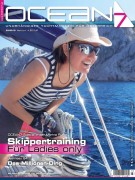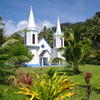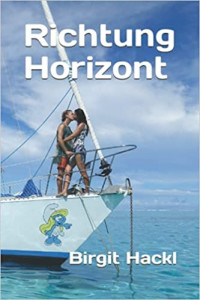For the past week we’ve had a convergence zone sitting between here and Tahiti and three lows have moved over Raivavae giving us just a one-day break with sunny weather which we used to rent bikes and cycle around the island. Otherwise it’s been rainy, grey and windy, so we spent the time doing indoor chores on a–depending on the wind direction–more or less bouncy Pitufa.
2015
11
May
2015
06
May
Quite some weather
Raivavae is supposed to have the best anchorage in the Austral islands, but from the N and W only the outer reef gives protection. We had pretty nasty weather last night and today. Strong winds from N-NW (of course!) and several squalls with gusts up to 45 knots caused Pitufa to rock and roll in the anchorage. It was particularly bad around high water (now is spring tide!) when the reef cannot entirely keep awyay the massive waves.
At the moment, the South Pacific Convergence Zone (SPCZ) is brewing up quite some weather between Samoa, the Cook Islands and here, mass-producing troughs and depressions like on a conveyor belt. And the GRIB forcast sees the next depression moving right over Raivavae in a couple of days…
2015
03
May
Quiet hiker’s paradise
Raivavae’s a small island, the coastal road that goes all around is only 23 km long. There are two ‘route traversiere’ (paths across from north to south) and we walked both of them last week. The tracks lead up the ridge through lush vegetation, large taro fields and countless banana plantations (who can eat so many bananas??). The scenery resembles the Society Islands and so does the ‘Ia orana’ the friendly locals shout out from their gardens. Down on the coastal road again we walked along the southern coast past little houses with manicured gardens and nice views of the narrow lagoon and the motus on the barrier reef. We had hoped to hitch a ride back to Rairua, but the only vehicles that passed us were bicycles, even though we saw cars next to most of the dwellings, so we walked all the way to the eastern cape and then along the northeastern coast, where the cliffs of the mountains ridge rise vertically skywards.
We had heard that it was possible to hike up to Mount Hiro (the highest mountain) from that side and after admiring the stunning view, decided to inquire about the path at the first house we saw a man mowing the lawn. The answer was a simple ‘oui’ and a big grin. Did he know where exactly the path started? Yes, here! What, in this village? No, right here! With an even wider grin he showed us around the house where a narrow footpath leads into the thicket. What a coincidence that we asked at exactly the right house… We’ll return next week for this rather ambitious hike.
Now it’s the weekend and we expected the same hustle and bustle that we’re used to from the Gambier, where fishing boats zoom out into the lagoon, children jump from the dock, youngsters plays loud music from their cars, families spend the day sunbathing and swimming on the village beach or take picnics out to the motus and the smell of BBQ hangs in the air. But nothing like that is happening here. It’s almost creepy quiet, only the sound of church bells breaks the silence–numerous denominations fight for the souls of the few islanders here… French cruisers who have spent the cyclone season here, just told us that it’s even forbidden to take a boat out into the lagoon on Sundays.
2015
01
May
Article on Raiatea and Tahaa in Ocean7 Magazine

Birgit Hackl, Christian Feldbauer: Raiatea & Tahaa — Südsee leicht gemacht, OCEAN7 03 (Mai/Juni) 2015, p. 20–24.
2015
01
May
Pitufa in the Austral Islands
The Îles Australes are the southernmost and least visited islands of French Polynesia. We have started exploring Raivavae and we’ll see how many more stopovers on the way to Tahiti can fit into our schedule…
2015
29
Apr
Landfall in Raivavae
When we arrived at dawn, the island looked spectacular with clouds rolling over the vertical cliffs of the mountain, illuminated by fiery rays of fresh sunlight. As last night was rather strenuous with squalls, torrential rainfall, and confused, lumpy seas, we rested for a while after we’d dropped the anchor and only went for a quick stroll to the village of Rairua in the afternoon. This place is so sleepy that little Rikitea in the Gambier feels like a bustling metropolis.
2015
27
Apr
Going bananas
No, we’re not going mad on Pitufa, but the stack of bananas we’ve brought from the Gambier has turned from green to yellow overnight–yep, all of them. At least we won’t go hungry, despite the fact that the fishies still refuse to hop on board. We crossed the tropic of capricorn last night, so we’re no longer officially in the tropics (the Gambier lie just above, Raivavae just beneath).
2015
25
Apr
Banging and clanging along
Last night the wind died down and Pitufa staggered through the confused waves with banging sails. We tried to optimise (tighter preventer, less sail area, etc.), but the nervewrecking cacophony went on. It’s not just the noise and the shaking that goes through the mast and rigging all throughout the boat, it’s also the knowledge of the damage done to the material that makes these situations so annoying. At 5 in the morning we gave up and motored for a while. The first light revealed that during the night the decklight had been shaken out of its broken housing and a mast slide was broken. We hoisted the gennaker, Christian climbed the mast to rescue the decklight before the shards could be shattered over the deck and we started experimenting with our old lightwind sail to make a few miles. We hoisted it starboard, then to port, tried flying it from a pole like a spinnaker and soon discovered yet another little tear in the worn-out fabric. Down with the sail, repair tape on and back up with it. Imagine all these manoeuvres carried out by two people who hardly got any sleep the night before which doesn’t help the general coordination of all the lines involved. Under such circumstances we don’t refer to port and starboard, we’re glad when we know left from right or at least agree on the same left/right. Leeloo used the calm weather for a walk around the deck and to check out what we were doing, but she has learned long ago to stay out of the way of moving lines and working sailors, so she soon returned to the safety of the cockpit. After fabulous daily runs of 140 nautical miles on the first two days, we managed meagre 79 today. 360 nm to go!
2015
22
Apr
Out on the ocean again!
Yesterday morning we checked the grib again and realised that we wouldn’t be able to set out during the following week towards Rapa. As we’re running late already, we decided to go to Raivavae (also one of the Australs) instead. We changed the small yankee against the big genoa (buried underneath all the secured stuff in the forecabin) and set out in the afternoon. Now Pitufa’s heading steadily west with a strong southeasterly behind her. We hope to reach Raivavae in about a week.
2015
21
Apr
Weather games
Waiting for a weather window is always frustrating. We get new forecasts twice a day and then the strategic games begin: we try to “sail” the cursor in expected daily runs through the area of the grib file where arrows indicate the wind speed and direction, trying to avoid becalmed zones and galeforce winds. Of course the further into the future the prediction goes, the more the planning resembles crystal-ball watching…
Anyway, we’ve been waiting for wind to go to Rapa now for 3 weeks, which lies south of the trade wind belt, has depressions moving by on a regular basis and isn’t easy to reach. We went to get the very last veggies time after time, kept Pitufa in oceangoing shape and kept on hoping. For the last 3 days the grib looked really promising, so we deflated the dinghy and secured it on deck, baked bread for the passage this morning, drugged the cat with her anti-seasickness medicine and were about to lift the anchor, but then we decided to get a last-minute grib. The damn thing had changed completely since yesterday, a low had changed course, gone was the steady wind for the trip, instead we’d be becalmed for two days only to arrive with scary strong winds in the tricky anchorage of Rapa.
We’ve learned the hard way that heading out into an unstable weather situation guarantees an uncomfy trip, so we’ll stay a bit longer and we’ll keep on playing the weather game…
2015
16
Apr
Winter is coming
Until three days ago it was really hot and calm, but then southerly winds set in, sending up chilly air masses with best regards of the icebergs down there ![]() The weather forecast had predicted light westerly winds, so we were anchored off the western motu Tenoko when a procession of squalls approached, hiding Taravai and Mangareva behind a dark grey wall. When the squalls reached us, the wind shifted south (not so nice being suddenly with the stern towards the outer reef and fetch building up over the lagoon), so we decided to head to the shelter of the village anorage of Taravai. We motored there against 25 knots of wind and heavy rain, reached the channel into the anchorage just before dark and the helmswoman was surprised and relieved how smoothly the manoeuvre through the tricky corners of the entrance went, despite gusts on the beam and the barely visible landmarks. Good that we’ve practiced that narrow, shallow entrance so often in good conditions before…
The weather forecast had predicted light westerly winds, so we were anchored off the western motu Tenoko when a procession of squalls approached, hiding Taravai and Mangareva behind a dark grey wall. When the squalls reached us, the wind shifted south (not so nice being suddenly with the stern towards the outer reef and fetch building up over the lagoon), so we decided to head to the shelter of the village anorage of Taravai. We motored there against 25 knots of wind and heavy rain, reached the channel into the anchorage just before dark and the helmswoman was surprised and relieved how smoothly the manoeuvre through the tricky corners of the entrance went, despite gusts on the beam and the barely visible landmarks. Good that we’ve practiced that narrow, shallow entrance so often in good conditions before…
The cool southeasterly’s still blowing and many boats that have spent the cyclone season here, use it for a downwind ride to the Tuamotus or straight to Tahiti. Pitufa and her crew are also ready to go, but as we’re still hoping to make it to Rapa in the Iles Australes (the southernmost island of French Polynesia) this weather window didn’t really work for us and we’ll wait for the next one.
2015
10
Apr
Article on Keeping Nightwatches in current (April) All-at-Sea

Birgit Hackl: Night Watches, All At Sea Caribbean, April 2015, p. 34–37. Free download from allatsea.net.
2015
03
Apr
New attractions on Taravai
Autumn’s gifting us with gorgeous weather here this year. Last year it was already cool and windy in April, but at the moment we’re enjoying perfectly calm, sunny and hot days. Just looking over the pastel shades of the lagoon in the early morning when the mountains are reflected in the sea like in a mirror with the corals gleaming through the crystal clear water, we feel almost obliged to seize the day. So we split the days between chores that need calm weather (cleaning the hull, climbing the mast to check the rigging, etc.) and fun like kayaking, snorkeling, hiking and hanging out ashore on Taravai. Taravai’s getting more and more attractions: an extended petting zoo and hiking trails! Additional to their two charming goaties, Pierre and Lolo now have two horses and Valerie and Herve have two kittens and two puppies ![]() It was always difficult to hike on Taravai, as we had to cut tunnels through the dense vegetation and make our own trails. If you try something like that yourself, always bring a machete with you and think of our memorising rhyme when planning the ascent: pine, your’re fine, reed, you bleed
It was always difficult to hike on Taravai, as we had to cut tunnels through the dense vegetation and make our own trails. If you try something like that yourself, always bring a machete with you and think of our memorising rhyme when planning the ascent: pine, your’re fine, reed, you bleed ![]() Now it’s much easier, because Pierre has made a huge effort and has cleared a path along the old, overgrown road all the way from the village to the southern bay of Taravai. We walked it yesterday, it takes about 1 hour each way and features lovely views.
Now it’s much easier, because Pierre has made a huge effort and has cleared a path along the old, overgrown road all the way from the village to the southern bay of Taravai. We walked it yesterday, it takes about 1 hour each way and features lovely views.
2015
26
Mar
Photos of Akamaru

Akamaru, Gambier Islands
In 2015, during our third visit to the Gambier islands, we finally made it to Akamaru. Its anchorages are a bit inconvenient, but this lovely island is definitely worth the effort.
(24 photos)
2015
25
Mar
Motu Tenoko
Last weekend the remnants of cyclone Pam (the one that devastated Vanuata) passed by far to the south and despite of the huge distance and its dwindling force it still sent up an impressive 4-metre-high swell. We watched the breakers on the sandbanks and reefs inside the lagoon from the safety of the anchorage in front of the village of Taravai.
As soon as the swell got down we used a very unusal prolonged phase of westerly wind to visit the western side of the archipelago that we’d missed up till now. We anchored off the one single motu (Tenoko) in the west and were once again impressed by the diversity of the Gambier. The tiny motu’s quite pretty with a sandy beach where a small colony of greater crested terns resides, some pine trees and coconuts, but mainly endemic shrubs that seem to be the favourite landing place of some red-footed boobies (rather rare around here). North of the motu the outer reef reaches up high and gives good protection to the lagoon, but south of the motu it is a few metres submerged. Yesterday the wind was very light and the sea calm, so we took the opportunity to paddle out on the ocean with our kayak and to snorkel back in. Dozens of sandy channels divide the shelves of hard coral and we were amazed by the amounts of groupers, surgeon fish, butterfly fish, trigger fish and other colourfu l reef fishies. Curious black- and white tip reef sharks accompanied us on that trip–we just couldn’t get enough and explored one channel after the other.




